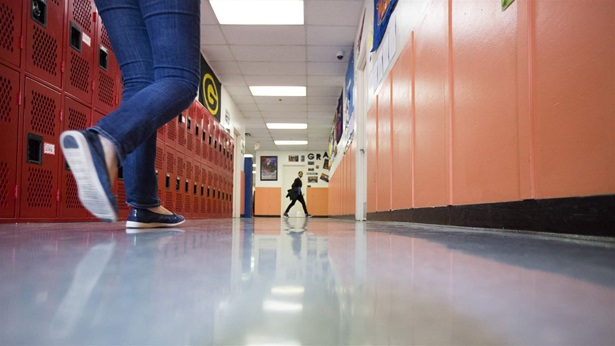How Much Broadband Speed Do Americans Need?
As COVID-19 makes fast internet connections more critical, policy expert discusses the possibilities and key considerations

As COVID-19 makes fast internet connections more critical, policy expert discusses the possibilities and key considerations
The COVID-19 pandemic has increased attention on the crucial role that high-speed internet access plays in American life. In a time that demands social distancing, broadband connections allow people to work from home, connect with classrooms, access health care services, apply for public assistance, and perform ordinary household activities such as ordering groceries or prescriptions.
As more Americans become increasingly reliant on broadband services, speed becomes a more important factor. How fast does an internet connection need to be? What factors go into answering that question?
John Horrigan is a senior fellow at the Technology Policy Institute, a think tank focused on exploring major issues related to information technology and communications policy, who has studied home broadband adoption. Earlier in his career, he served as research director for the Federal Communications Commission team that developed the National Broadband Plan, which was released in 2010. He recently answered questions about internet speeds. This interview has been edited for clarity and length.
Q: First and foremost: What is broadband?
A: Broadband is reliable high-speed internet. The current definition set by the FCC is speeds of 25 megabits per second for downloads and 3 megabits per second for uploads. Policymakers periodically revise definitions of what counts as broadband service—which as recently as 2010 was defined as speeds of 4 Mbps/1Mbps—to reflect improvements in technology and changes in customer demand.
Q: Why does connection speed matter?
A: The speed impacts how quickly information is transferred. It’s measured in terms of both download (how quickly things move from the internet to your device, such as how long it takes to load a YouTube video) and upload (the speed at which content is transferred from your device to the internet, such as how well a video call transmits from your home office). Speed affects people’s experiences, including how they can use digital applications such as websites, streaming video services, videoconferencing systems, or online education platforms. People want applications to run fast: A webpage should load quickly, and videos should run without buffering. And they want little latency—the time between the click of a link and the response on the other end.
From the perspective of policymakers, internet speed is important because of Section 706 of the Telecommunications Act of 1996, which states that the FCC should encourage deployment “of advanced telecommunications capability to all Americans.” The commission annually releases a report that makes a finding as to whether communications networks are being deployed in a timely and reasonable way. In April, the FCC found that network deployment met the burden of being timely and reasonable in 2019.
Q: How does broadband speed impact the things people can do online?
A: How much speed you need, and how you experience that speed, relies on multiple factors, including the applications and the number of people online. The devices being used also affect speed: the computer, router, and even broader infrastructure available to deliver the connection can all impact speed and user experience.
Not all online activities require the same speeds: For a group video call, 2.5 Mbps speeds suffice, while streaming videos may require 25 Mbps for high-definition quality. As a result, a single-person household may be fine with an internet service provider’s (ISP’s) basic service offering. But many factors affect even the highest internet speeds.
For example, the number of connected devices and amount of activity occurring simultaneously can slow down speeds. Take a common example as the nation responds to the pandemic: If two parents are conducting video meetings while two kids are logged in to online classrooms or trying to watch streaming video at the same time, some may experience slower or interrupted connections, even if they’re signed up for the fastest home internet service.
More complex or technologically advanced tasks may require higher speeds. Virtual reality (VR) applications that immerse users in digital environments require at least 50 Mbps to work. In addition to gaming or entertainment uses, these tools are used in other contexts too: Libraries use VR to provide cultural content for patrons, while community colleges use these tools for job training services. These applications are especially pertinent now, as cultural institutions work to deliver content remotely and schools explore ways to provide trainings that require hands-on experience.
Speed has been increasingly important as Americans have become more reliant on the internet for everyday activities and use more bandwidth-intensive applications more frequently. Monthly data traffic in the United States was 33 million exabytes—an exabyte is 11 billion gigabytes—in 2018 and 42 million in 2019. The pandemic has resulted in 18% growth in in-home data use, comparing March 2019 to March 2020. The typical U.S. household has 11 internet-connected devices, and research indicates that this trend will likely grow.
Q: What do broadband speeds look like across the country?
A: As the FCC’s threshold speeds for broadband have changed, so have the speeds that households can subscribe to and receive. Many ISPs advertise services of 100 Mbps or more. And the FCC’s “Measuring Broadband America” found that the median household speed for broadband service grew from 15 Mbps (download) in 2012 to 39 Mbps in 2015 and 72 Mbps in 2017.
But some areas still lack access to internet service at broadband speeds. According to the FCC, just over 5%, or 18 million people, lack access to broadband, including 20.7% in rural areas. Some estimate the number of people without broadband access as high as 42 million.
Q: Why do some locations have slower broadband network speeds than others?
A: Population density plays a big role in explaining speed variations. Broadband service that runs over cable or fiber optic networks tends to be the fastest, but those networks are expensive to build. As a result, these providers invest in the urban and suburban areas where many potential customers live close together and have the disposable income to pay for service.
Small towns or remote rural areas are different because their populations may make it unprofitable to operate cable TV or internet service. Many rural areas are served by digital subscriber line (DSL) service, which operates over traditional copper telephone networks and is not as fast as cable or fiber. Rural and remote areas may also have access to fixed wireless, which has variable speeds depending on a household’s proximity to the signal’s source, but that is generally slower than DSL service.
Q: What has the COVID-19 pandemic taught us about broadband speeds?
A: The pandemic has caused a large increase in home internet use. Data use on wireline networks was 47% greater in March than the year before and the cable industry has reported that data use among cable modem service customers increased by 38% between March and late October 2020. The dependence on broadband for work and school has shed light on the speed and reliability of home service. By some measures, broadband networks have performed well, with one analysis showing that home speeds were 94.6 Mbps in July compared with 84.9 Mbps in March. Other measures, especially early in the pandemic, showed decreases in network speeds as more people logged on at home.
Many applications that people have relied upon during the pandemic—such as videoconferencing platforms or streaming video—do not necessarily need fast speeds to function, but when multiple people in a household need a video application, network performance may suffer.
Additionally, those reliant on only smartphones for access, beyond worrying about data limits, may find that some video applications do not function well. This phenomenon may be significant because some 17% of Americans are “smartphone only,” including 26% of low-income households. For low-income students who have only smartphones for remote classroom access, the limitations of these devices for learning have become quickly evident.











